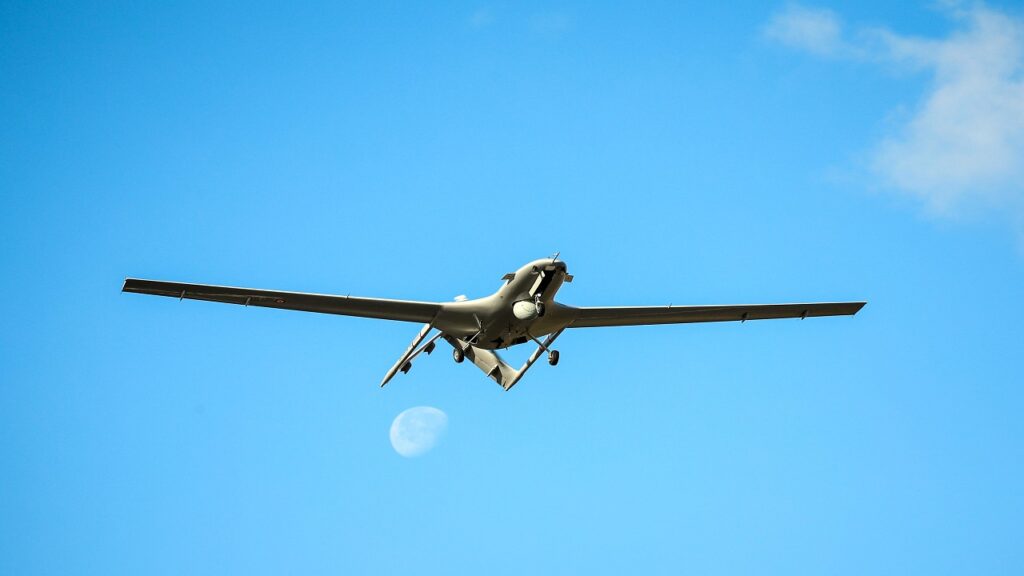
Bayraktar TB2 is a medium altitude and long-range (MALE) tactical unmanned aerial vehicle (UAV) system manufactured by Baykar Makina, for the Turkish Armed Forces.
A detailed list of Russian targets confirmed to have been destroyed or taken out of action by Bayraktar TB2s over Ukraine can be viewed below. This list only includes destroyed vehicles and equipment of which photo or videographic evidence is available. In some cases this solely consists of footage that was recorded on the ground. In these cases, the use of an armed drone was reported by witnesses on the ground. In an effort to attract as little attention to its operations as possible, very little footage of TB2 strikes over Ukraine has been released. Therefore, the amount of equipment destroyed by TB2s is significantly higher than recorded here. The list will be updated as additional footage becomes available.
SEE ALSO REPORT FROM 24 FEB 2022 Attack On Europe: Documenting Equipment Losses During The 2022 Russian Invasion Of Ukraine
Bayraktar TB2 is a medium altitude and long-range (MALE) tactical unmanned aerial vehicle (UAV) system manufactured by Baykar Makina, for the Turkish Armed Forces.
Bayraktar tactical UAV was developed by Kale Baykar JV, a joint venture of Baykar Makina and the Kale Group. The UAV is an ideal platform for conducting reconnaissance and intelligence missions.
Bayraktar TB2 achieved the milestone of 200,000 operational flight hours in June 2020, becoming the first domestically built aerial vehicle in the country to reach the feat.
Bayraktar tactical UAV development
Phase one development of the prototype Bayraktar Block A began in 2007 and first flight was made in June 2009. The contract for phase two development and serial production was signed between the Undersecretariat for Defence Industries (SSM) and Kale-Baykar JV in December 2011.
The second phase involving the development and serial production of Bayraktar Block B (TB2) commenced in January 2012. Bayraktar TB2 completed its first flight in April 2014. The first acceptance tests of the UAV were conducted in November 2014 and six UAVs were delivered to the Turkish Land Forces by 2014.
A second batch of six indigenous Bayraktar TB2 UAVs was handed over to the Turkish Land Forces in June 2015.
Baykar developed and supplied six TB2 drones to Ukraine under an agreement which was signed between the two countries in January 2019 for the delivery of 12 TB2 UAVs for the Ukrainian Army. Three additional drones were delivered to the Turkish Gendarmerie in May 2020.
Design and features of Bayraktar TB2
Bayraktar TB2 features a monocoque design integrating an inverse v-tail structure. The fuselage is made of carbon fibre, Kevlar and hybrid composites, whereas the joint segments constitute precision computer numerical control (CNC) machined aluminium parts.
The engine is positioned between the tail booms and fuel is stored in bladder tanks.
Each Bayraktar TB2 system consists of six aerial vehicles, two ground control stations (GCS), three ground data terminals (GDTs), two remote video terminals (RVTs) and ground support equipment.
The UAV has a length of 6.5m, wing span of 12m and a maximum take-off weight of 650kg.
Bayraktar TB2 avionics and payload
Designed for short range reconnaissance and surveillance missions, Bayraktar is currently operational with the Turkish Land Forces.
The UAV is equipped with a triple redundant avionics system. An onboard avionics suite encompasses units, including microcontroller, engine control, servo motor power control, engine signal processing and I/O and GPS receiver units.
It also features a Pitot static sensor, laser altimeter and alpha beta sensor modules, as well as speed, temperature and fuel level sensors.
Bayraktar TB2 UAV has the capacity to carry a payload of 150kg and operate during day and night.
The standard payload configuration includes an electro-optical (EO) camera module, an infrared (IR) camera module, a laser designator, a laser range finder (LRF) and a laser pointer.
Flight control and navigation
The redundant flight control system allows autonomous taxi, take-off, navigation, landing and parking operations without assistance from any external sensor. Sensor fusion architecture using modern non-linear control techniques ensures good control and guidance of the UAV. The unmanned vehicle is also capable of employing semi-auto modes during missions.
Bayraktar TB2 ground control station
Bayraktar TB2 UAV is controlled by a ground control station based on a NATO spec ACE-III mobile shelter unit. The module integrates pilot, payload operator and image exploitation consoles.
The station is equipped with rack cabinets, air conditioning unit, NBC filtration system, power supply units, wireless systems and internal communication systems.
Engine and performance of tactical UAV
The power plant integrates a 100hp internal combustion engine driving a two-bladed variable pitch propeller. The tactical UAV has a range of more than 150km and can fly at a maximum altitude of 27,030ft. It has a maximum speed ranging between 70kt and 120kt and endurance of 27 hours.




